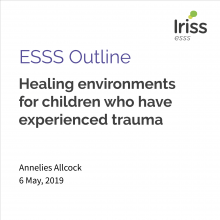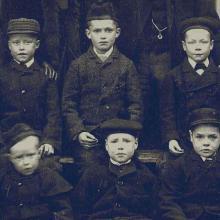Dr Ruth Emond and Dr Samantha Punch speak about a research project that they were involved in around food practices in residential children's homes. The significance of food to both children and the adults in the home is discussed. The project involved a research fellow living alongside the children and the staff for just under a year. It also involved individual interviews and focus groups with children and staff.
They identified that food has huge significance and was used by adults and children to communicate, express and manage a range of feelings and behaviours. Interestingly staff could intend something as a caring gesture, but children could be interpreting it as quite a controlling, inflexible way of going about things. For instance, staff might think it was nice to have regular meal times where everyone came together to sit around a table, whereas the children thought that could sometimes be intimidating, having to sit with everyone when you weren't necessarily in the mood.
There were also issues around the level of choice, sometimes children didn't want the pressure of having to make decisions for themselves. What they wanted was staff to know how they felt about food and that they wanted it to be more flexible, to respect their privacy and enable them to make a choice about whether to participate or not. For the staff they often placed high value on routine and issues around health and safety.
One of the major findings was about the symbolism of food, so food being used as a symbol of control or of care. Food often became one way to communicate certain things that they felt they couldn't communicate in other ways - so feelings of care, even feelings of love, belonging or togetherness. Also children sometimes showed their resistance to wider things (care, rules, expectations etc) through refusing food or to participate in activities around food.
More information on the research
Punch S, Dorrrer N, Emond R and McIntosh I (2009) Food practices in residential children's homes: The views and experiences of staff and children (PDF), Stirling: University of Stirling.
Further resources
- Dorrer N, McIntosh I, Punch S and Emond R (2010) Children and food practices in residential care: Managing ambivalence in the institutional home,Special Edition of Children's Geographies, 8 (3), 247-260
- Emond R, Dorrer N, Punch S and McIntosh I (2009) Children's views on food in residential care, information leaflet for children and young people, Stirling: University of Stirling
- Emond R, McIntosh I and Punch S (In Review) Food and feelings in residential child care, submitted to the British Journal of Social Work
- McIntosh I, Punch S, Dorrer N and Emond R (2010) You don't have to be watched to make your toast: Surveillance and food practices within residential care, Surveillance and Society, 7(3), 287-300
- McIntosh I, Dorrer N, Punch S and Emond R (2011) 'I know we can't be a family, but as close as you can get' Displaying families within an institutional context, in Dermott E and Seymour J (eds) Displaying family: new theoretical directions in family and intimate life, Basingstoke: Palgrave Macmillan
- Punch and McIntosh (Forthcoming) Food is a funny thing within residential childcare: Intergenerational relationships and food practices in residential care. Paper being revised for publication in Childhood.
- Punch S, McIntosh I, Emond R and Dorrer N (2009b) Food and relationships: Children's experiences in residential care, in James, A, Kjørholt A.T. and Tingstad V.(eds) Children, food and identity in everyday life, Basingstoke: Palgrave Macmillan
- Punch S, McIntosh I and Emond R (2011) Children's food practices in families and institutions, London: Routledge. Also published in 2010 as a Special Edition of Children's Geographies, 8 (3), 227-232
- Punch S, McIntosh I, Emond R and Dorrer N (In Review) 'Children, food and residential care: Ambiguities of applying rights in everyday practice, submitted toSociology.
Ruth Emond and Samantha Punch, recorded February 2012
Ruth Emond(RE) We are going to talk a little bit today about our research projects that we were involved in that related to food practices in residential children's homes. My background is as a residential social workers and I had went on to do my PhD looking at young people in residential care and how they formed friends and peer relationships. And as part of that I lived in a residential unit for a year to undertake the research - and one of the things that became very apparent as a kind of pseudo resident was the significance of food and how much of a part food played in the day to day life of both the children and of the adults. So out of that I suppose grew an idea about looking at that more rigorously, and Sam and Ian brought their expertise as sociologists, and Sam has a particular knowledge of both ethnography and sociology of childhood, to think together about how we might look at the role of food in residential care. So because we wanted to look at that sort of everyday-ness and the sort of impact that food has every day, we opted to do an ethnography. So an ethnography that basically means that Nika, our Research Fellow, lived alongside the children and the staff, again for almost a year, although this time in blocks because we involved 3 residential units. So Nika spent 12 weeks in each, and that allowed her to see all times of day or night for children and for staff, and to think about the part that food played in those very kind of everyday activities. On top of all the data that she gathered just from watching and listening to the people around her, we also did some kind of set interviews, individual interviews as well as focus group interviews, both with children and with staff. So over that time period we generated a huge amount of data, and I suppose came to a very sort of firm conclusion that food had huge significance and was used by adults and children to communicate and express and manage a whole range of feelings and behaviours and relationships.
Samantha Punch (SP) Certainly within the sociology childhood in the last 10 years or so, there has been a big drive to seeking children's views, and sometimes overlooking the adult's perspective as well. And what we found was quite important is to get the intergenerational perspective here, because for example staff could intend something as a caring gesture, but children could be interpreting it as quite a controlling, inflexible way of going about things. So for example, the staff thought it was nice to make the care home like a family home and have regular meal times where everyone came together and sat round the table - whereas the children thought that that was inflexible and too rigid, and sometimes could be a bit intimidating, having to sit with everybody when they weren't necessarily in the mood. And they wished, you know, that things could be a bit more flexible, that they could maybe have a later lunch by themselves, or a snack in their room - whereas the staff thought they were doing a good thing by bringing everyone together in a sort of family, homelike manner. So what they intended to be received in one way was received quite a different way by the children -by seeking both the adult's and children's views on that, that shed to light some of these issues, and then we communicated that to each other. And then the children found also that for them, being in care, you know, can be quite a pressured environment and they are forced to participate in a lot of things, because again the adults think that is good for them, that they should participate in choosing the menu and participate in the mealtimes, etc. But sometimes children just wanted adults to sort things out for them and didn't always want the pressure of having to make the decisions themselves. And what they wanted was staff to know how they felt about food and that they wanted it to be more flexible, to respect their privacy, so that they could choose whether to participate or not, and they had that choice rather than, you know, being forced into sort of set routines and structure. But the adults thought the structure was good for them and that having regular routines was going to create a safe environment. So for the staff it was all about health and safety as well, whereas for the children they wanted much more flexibility and room for manoeuvre and were less concerned about issues around health and safety. So it did shed light on these things, and I think the units themselves, by being involved, then ended up changing some of their practice because of that and realising that actually having some more flexibility built into that structure and routine was quite a good thing. And some of them even said to us, didn't they, that previously they thought they were doing what was best, in the child's best interests and for the children - whereas now actually really listening to the children and what they thought and how they received things meant that they ended up doing things quite differently.
RE Yes, I suppose one of the big things that we found out was that food carries this huge symbolism - so it's thinking about the activities that take place around food and what they symbolically represent. So Sam's example is a really good one where food was used as a symbol of care, but was heard as a symbol of control. So part of, I suppose what our project highlighted, was the importance of symbolic communication being shared, so an understanding of what was trying to be communicated by both parties. But I suppose linked to that it was really interesting to look with the staff and the children about the extent to which they didn't necessarily feel as if they had huge kind of power to make decisions. So food often became the one way that they could communicate certain things - that they maybe felt they weren't allowed to. So for the staff, food became a vehicle of communicating often sort of feelings of care, or feelings even of love and belonging and togetherness, that maybe in this kind of managerialist sort of culture of care practices, it is more dangerous I suppose to say to a child "I really care about you, I really love you" - but to show the child that by remembering their favourite food or making sure that they know the particular way they like their tea - it has such power for the child to kind of receive that sort of connection. And similarly for children to be able to communicate their love and affection and their knowledge of the people who look after them, to create that sense of kind of belonging, was often done through food, through knowing what each other's like and dislikes were and through knowing the special ways that people like food ... it's such an intimate, personal thing food, isn't it? But I think too it can be hard for children and adults in that setting to feel that they have sort of control. So children sometimes showed their resistance to wider things - so resistance to care or resistance to the rules or expectations, by food refusal or refusing to participate in the activities around food. So while it was harder to maybe articulate "I don't want your affection, I don't want your care, I don't want your belonging, I don't want these things that you are offering me" - it was easier to say "I'm not eating your dinner", "I'm not eating what you have prepared for me to show me that you care about me". So I think again the symbolic nature of what was being communicated was really interesting, and I suppose clearly demonstrated by both children and young people and staff, and that was staff from a range of different positions, so from managers to residential staff, to cooks, cleaners - they all bought into this kind of symbolic way of communicating and weren't necessarily aware that that is what they were doing. So I suppose a lot of what our project was about was making people much more aware of the symbolic power, I suppose, of food and what really was being communicated, what was behind the actions of the child or of the adult and what did they want to communicate. So I suppose that was one of the main things in terms of application to practice or to policies, thinking about "what do we want to communicate to children in our care about them? And how do residential units marry that with some of the more kind of bureaucratic responsibilities that are placed on them in terms of health and safety practices around food, around bulk ordering or around choices around diet. And there were real tensions between being able to provide the kind of nurturing food related care, and at the same time adhering to certain practices.
SE It was one of the key things of the project, the ambivalence and ambiguity that surrounded food and food practices, because there were lots of contradictory messages given to both the staff themselves as well receiving them from external forces, about "food has to be delivered around these structures and routines" - yet equally, on the other hand, you know, they have got to enable children to participate and have a sense of belonging. And as Ruth's example gave there, there is that tension there - you can't necessarily do both. So for example one of the homes was much more laid back and flexible around those health and safety regulations and routines and interpreted them in very loose ways, because they realised that building relationships was probably sometimes more important than sticking to rigid guidelines about what children can and can't do all the time, and actually bridging that gap, the generation gap between the adult staff and the child and young person, you know, is difficult to do. And if you put relationships at the forefront rather than the rules and routines, then you are probably going to get a better outcome in the longer run. And often, as Ruth said, that is done through food.
RE If you are thinking symbolically, if you are thinking about what else is being communicated underneath the actions and behaviours, then it gives you a way in, a sort of neutral way in to some quite difficult work, but work that needs to be done in terms of helping children recover and repair and move on. So I suppose yes, from a findings point of view we felt that food has enormous potential and the practices around food has enormous potential to help children be nurtured and recover from the absence of nurture, to help children feel as if they belong, to help children feel connected and to make relationships. But also for children to learn how to make decisions, and to negotiate, and to participate - so just in the day to day activities around food, really powerful things were being experienced by children - and when it was managed well, that was hugely positive.
SP But sometimes the mismatch of those interpretations of what was going on that was really communicate to the staff that this was going on, that sometimes their actions were being misinterpreted by the children. So for the children it was wanting staff to be aware that this was happening and what their needs and requirements were - but they didn't actually want to be ... and the next phase hopefully of the project will be to actually implement this into training, but it's more training for the adults and the staff workers rather than involving the children directly in that, because they just want to raise the awareness on behalf of the adults, so that they can communicate and can pick up on the signals of food - and then the relationship building will come out of that rather than ... the children were quite clear that they actually didn't want to be involved in the next stage of implementing it into practice - they just wanted to make sure that their voices had been heard and that things were going to be done differently.









